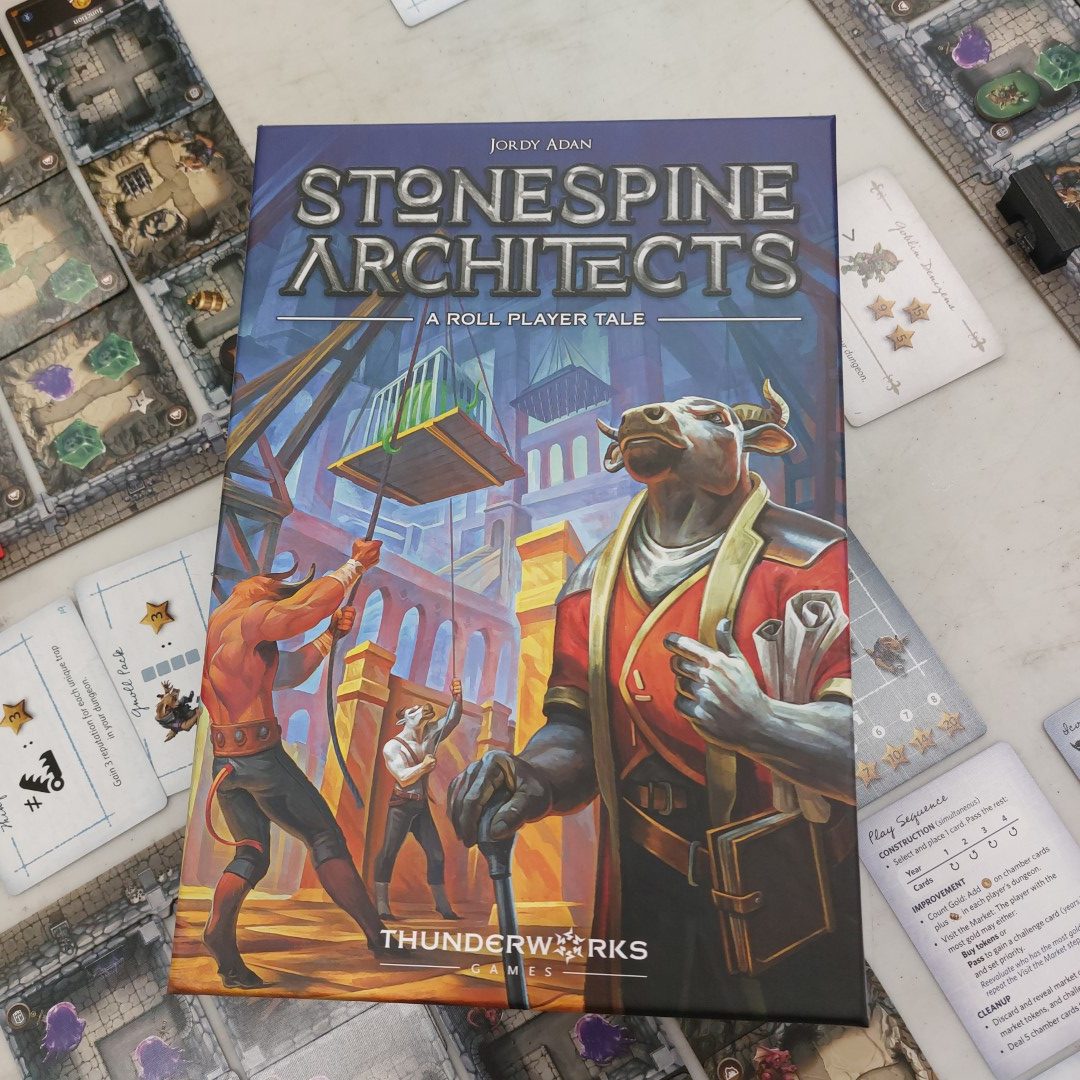That is how, Stonespine Architects was recently described to me as, Cartographers but with a sprinkle of just “more”. And I’m not sure how that conclusion could be drawn when you contrast a flip and write against a card drafting game, that probably feels like it borrows more mechanically from Roll Player than Cartographers and definitely more a 7 Wonders vibe. Stonespine Architects, sees you play as a minotaur, because everyone knows that a minotaur makes the best dungeon builder! And your tasked with building a new dungeon. In all honesty, the theme is here nor there and I wish it came through more strongly, as it’s just a drafting game at its core, wrapped around a space optimisation, puzzle type game, which doesn’t do anything fundamentally new or different and I think there may be a bit too much sprinkling of luck!
Over four rounds, you’ll resolve the three same phases before final scoring. And Stonespine Architects is breeze to teach, draft a card, place it, repeat. Market phase (taking money equal to those showing at the bottom of your newly placed cards + treasures chests), spend money on new traps, monsters and the like, obtain a new challenge (goal) card, and then clean up!
At the start of the game, a goal card is revealed which all players are competing towards, there’s a mixture of cards here, of most of, least of, there is however, only 8.
And I feel like there needed to be more. There are also blueprint cards, which are individual and gives each player a specific layout they’ll need to try and achieve to score points at the end of the game. My criticism here is that there are two types of dungeon cards (stone and caves) and weirdly they do look similar, especially at a quick glance in dark light settings. I get that they have icons in the top corner, but I can’t help but feel that different elements e.g. water, fire, grass, land could have been a better approach and more diverse in terms of colours. Although, I guess you could argue stone and caves are more thematically appropriate.
Each chamber card usually comes with a door and a path, although some do end on the tile. And some will have elements, which could be monsters or traps, or treasure chests, and every card will have a gold value (which could be 0!), all of these link into challenge, goal or blueprint cards that you are trying to work towards. And herein lies my first real challenge, there is no way to swap in or out cards in your hand or board, so if you get a bad hand, and considering how important placement can be, you are at the whims of luck!
The first phase of a round is construction, where you’ll add in an almost formulaic like approach cards to your dungeon, one row at a time. You can add them in any order to that row, but in round 1 you are limited to row 1, round 2 (year 2) you are limited to row 2 and so on. Paths aren’t required to link when you place them, but it’s generally a good idea to try and keep a path from your entrance going.
It does mean everyone builds at the same pace, but I can’t help but wonder if a freer approach of place adjacent to something you’ve already placed could be better and create a better decision space? After you’ve placed 4 cards, you’ll move to the market phase, which is where you’ll receive money to spend on various elements to add to your dungeon. And those with the most gold get to buy first, which adds some weight to the decisions around cards you add to your dungeon, as cards with higher gold values typically feel less valuable in terms of goal completion, so there is a balance to be achieved. You’ll keep going until all players have passed, and when you do pass, you’ll grab a challenge card, which feels a bit like a double-edged sword, early game, they appear doable and achievable, but as the game progresses, you realise that that round 1 card is far from achievable. Which in part could be down to the cards you were dealt. What follows is a quick clean up before the next round continues.
At the end of the game, you’ll score points for most things; blueprint cards, priority order, chamber reputation, challenge cards, goal cards and then paths, with you gaining one point for each card connected to the exit and one point for each connected to the entrance, meaning, you can score 2 points for each card that connects to both, which feels like a big scoring opportunity. But across the games, I’ve played I’m not sure its game winning, as it feels like there are better ways to consistently score points, although if you somehow manage the miracle of connecting all 16 to both, that’s a big 32 points! Although whether you manage that, may be solely dependent on the luck of the cards and whether the additional secret doors make it to market.
Overall, Stonespine Architects is easy to teach, and it feels like it fits into the space between spacial puzzles and drafting games and reminds me a little bit of Ecosystem. Although, I feel that there is a fair bit of luck in Stonespine, that doesn’t feel mitigated. You can be held on the luck of the cards, the luck of the market and that possibly is a little bit too frustrating.
There are some decisions here, the buying things in the market phase or passing early to get a good challenge card, felt each time like a decision between points and potential points. Although you will always get a challenge card, choosing one that is achievable is half the battle. And despite my previous criticism about the approach of whether being limited to a row is a good thing, it makes you play in a different manner to one where you could place adjacent. It’s kind of like Azul in a way, and you’re forced to play row by row over 4 rounds. However, my biggest criticism is the lack of being able to draw or replace cards, whether you can discard a previously purchased item to swap two cards in your hand or so, a hand of 5 cards that slowly decreases in size in the construction round, feels so restrictive that its almost punishing. Now you could argue that it’s making the most of what you’ve got, but if you’ve a hand of dead ends or chamber cards that all don’t work for you, there is no get out and I think that’s probably why Stonespine Architects falls a tiny bit short of greatness.
As you know I rate games on the following scale:
Buy or play
Wait for sale or play if you like game XYZ
Avoid
Stonespine Architects, gets an easy “Wait for Sale or buy if you like games like..”, if you’re a big fan of the world that Roll Player, Cartographers etc is set in, I suspect you may want to try Stonespine. Equally Stonespine Architects has some nice additions which bring it into that spacial puzzle style drafting game, which for me feels like its borrowed mechanically from Roll player (in the market) and there’s a hint of familiarity in the way you build a dungeon seeking to connect paths that feels Railroad ink esque. However, this is no roll and write or flip and write, and I’m struggling to see the comparison to Cartographers. The card drafting, which is a standard drafting, and you rotate which way you pass hands each round, doesn’t do anything fundamentally different, there’s no neat twist, unless you play at two, which sees you add a new card to your hand, which is a nice addition that I love! (But why can’t this happen at all player counts!) For me I’m not sure Stonespine Architects gains a place in my collection, its a game I would play again and come back to, and I don’t think I’d say no if I was asked to play again. However, its almost missing some final addition to keep on bringing you back for repeated plays, or least holding me back from repeated plays. Fundamentally, its alright, okay, an enjoyable experience, but I’m not sure it’s doing anything fundamentally, new, exciting or great.
It’s just enjoyable, but whether that will hold up for repeated plays, is a completely different question, after a handful of plays, I feel like I’ve seen all it has to offer (I probably haven’t seen all the goal cards) and there’s just not that same level of satisfaction that say Splendor has, which keeps me coming back. Maybe it’s the ease of rules of Splendor that makes it much easier to pick up and come back to, but Stonespine Architects has a little bit more complexity, albeit fractional. Its ultimately a point salad card drafting game, wrapped fairly loosely around a dungeon theme, which is alright! And therein, is the review.
Disclaimer: I was sent a copy of Stonespine Architects to review, I was not paid for this review and all thoughts remain my own

